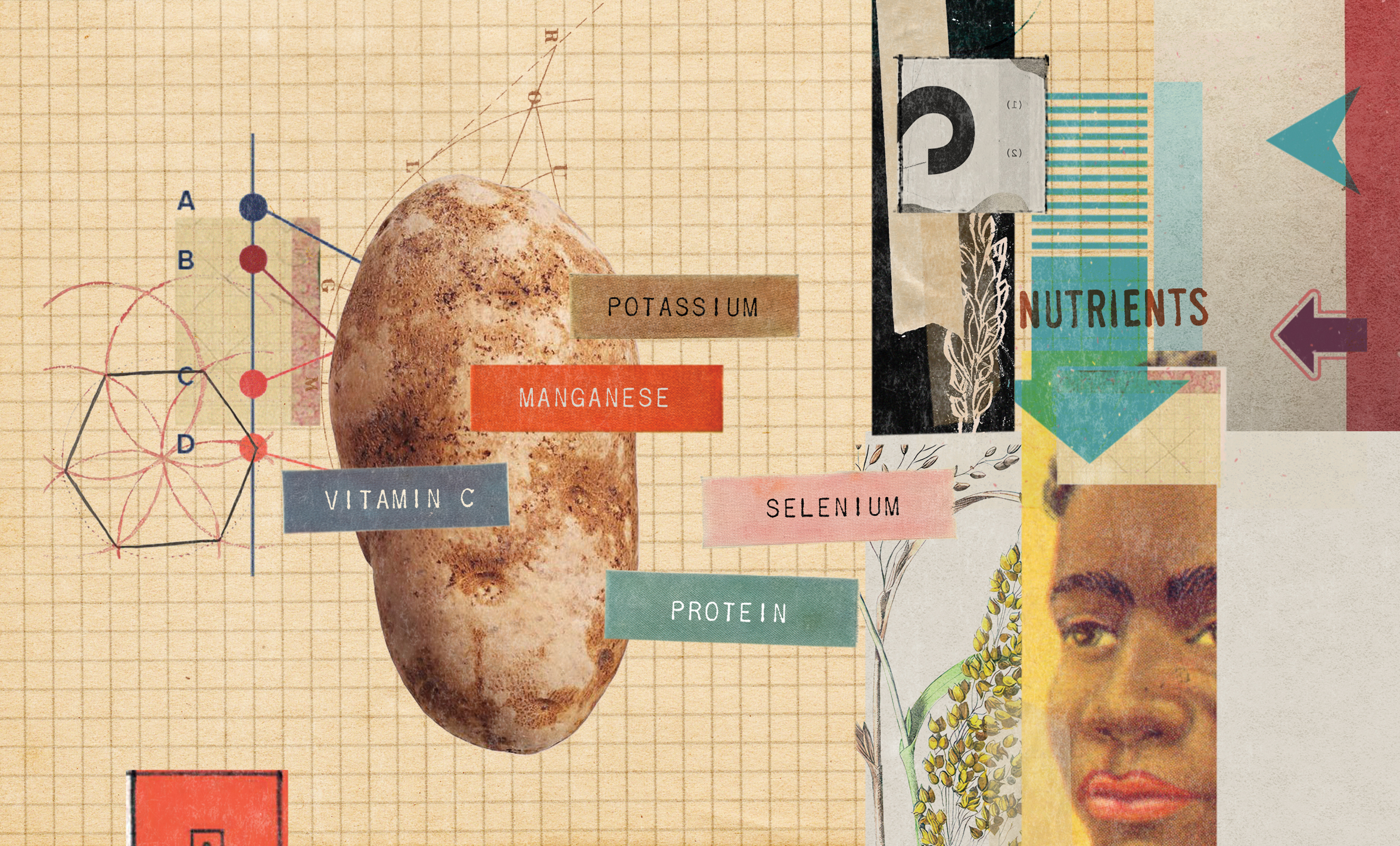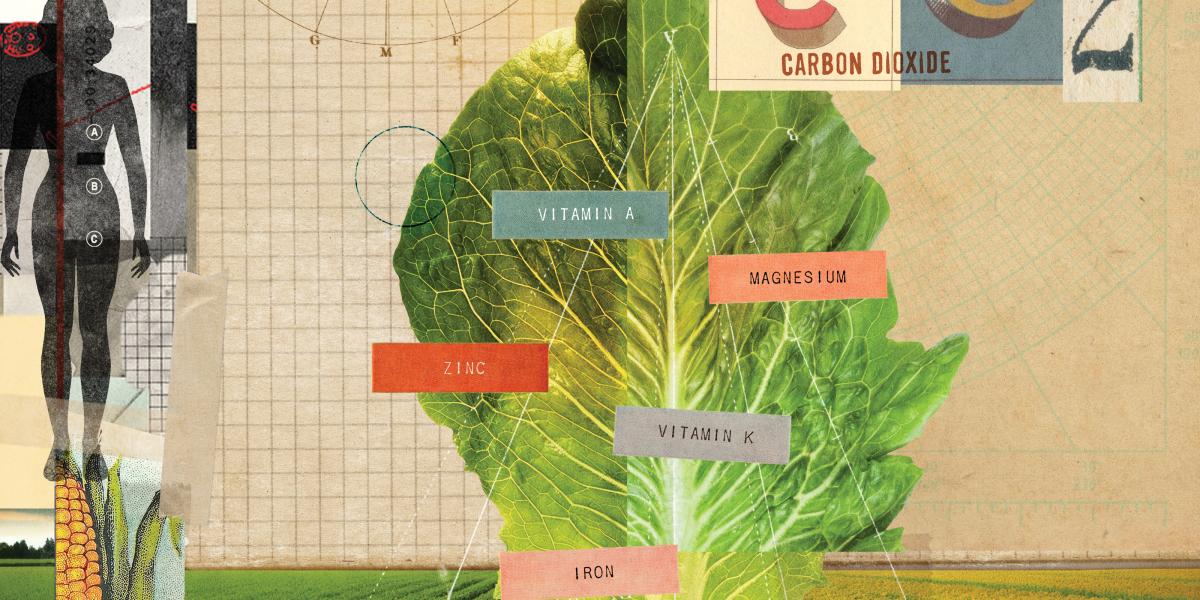Less Nutritious Crops: Another Result of Rising CO2
Rising carbon levels are eroding nutritional values of staple crops, threatening millions with hidden hunger.
From his 10-acre property in southern Mississippi, farmer Timothy Robb knows that invisible nutrients matter—for the health of plants and the humans who consume them.
The right balance of vitamins and minerals will make the salad greens he supplies to New Orleans restaurants darker in color and chock full of nourishment. If the proportions are out of balance, though, the plants may suffer in both nutrition and appearance. Take, for example, potassium deficits.
“You’ll see it on a head of lettuce,” Robb says. “The outer leaves on the lowest part of the tip will burn. There’s a black, brown, or wilting effect along the leaf margin.”
Robb can sprinkle chicken manure and study soil composition in the hopes of righting the ratios. But there’s another disrupting force he and other farmers can’t control: rising atmospheric carbon levels.
Scientists investigating the impact of increasing carbon dioxide on global staple foods like rice and wheat have made some concerning findings: Higher CO2 levels make many foods less nutritious, reducing protein, vitamins, and critical micronutrients like zinc and iron.
Micronutrient deficiency, or “hidden hunger,” is already a pervasive problem globally as a result of poor and restricted diets. A lack of crucial vitamins and minerals can affect humans in a number of ways, from increasing child and maternal mortality to impairing growth and development. More than 2 billion people worldwide currently face micronutrient deficiencies, including more than half of preschool children and about two-thirds of non-pregnant women of reproductive age, research has estimated. Declines in crop nutrients as a result of rising CO2 could exacerbate these threats to human health, especially for children and pregnant people in low-income countries.
“It’s a really strong example of planetary health: Something that we’re doing to the environment is impacting health,” explains Samuel Myers, MD, director of the Johns Hopkins Institute for Planetary Health and a professor in Environmental Health and Engineering. “As we change these complex systems, we’re seeing unintended consequences and unanticipated results.”
As people have burned fossil fuels for energy, Earth’s CO2 levels have risen steadily. Today, atmospheric CO2 is about 50% higher than pre-industrial levels, according to NOAA. Scientific research and news accounts often focus on the most visible effects of those increasing levels, says Lewis Ziska, PhD, MS, an associate professor of environmental studies at Columbia Mailman School of Public Health.
“A lot of attention is placed on ‘biblical outcomes’—sea level rise, to superstorms, to the end of the world as we know it,” he says. “I come at it from a botanical lens.”
From that perspective, Ziska and fellow researchers have investigated the impact of additional carbon on plants’ chemical components and the potential human health consequences. While atmospheric carbon can fuel plant growth, the effects of the additional carbon are more complex than just bigger plants. Crops grown under higher-carbon conditions increase the synthesis of sugars and starches while decreasing the concentrations of protein and nutrients. These findings are evident in global staple foods including rice, wheat, potatoes, and barley. (A much smaller percentage of plants like corn and sugarcane use carbon differently and haven’t demonstrated the same changes.)
The amount of nutrient decline varies by experiment and plant, and most experiments double the current CO2 levels. A 2018 review of 50 articles published in Frontiers in Plant Science found that when carbon levels rise, protein levels drop by nearly 10%, iron by 16%, zinc by about 9%, and magnesium by about 9%.
The precise mechanisms fueling the decline are still a mystery but likely have roots in the imbalance created by additional CO2, which the plant takes from the air and uses in photosynthesis. As plants pull water from the soil, they bring along nutrients like iron and manganese which help the plant grow. Adding more CO2 shifts the proportions, much like adding more of just one ingredient to a recipe.
“We’re seeing this imbalance in elements that make up plant growth, and the plant is adapting to that,” Ziska says.
Initially, scientists conducted the research in greenhouses and growth chambers with small sample sizes, says Myers. That led to some doubts as to whether the findings simply stemmed from the artificial growing conditions. To address those concerns, Myers led research combining 41 selectively cultivated varieties of six staple food crops grown across seven different locations on three continents over 10 years. These experiments were performed in open field conditions in which a ring of jets pumped out CO2 while sensors ensured that consistent concentrations would settle over the field. They mimicked the level of CO2 the planet will likely face in the next 30 to 80 years.
“It is a very specific way to reproduce real-world growing conditions, where identical cultivars experience the same soil, weather, pests, and pathogens, but differ only with respect to the CO2 concentration,” Myers says.

Once the studies demonstrated the widespread plant nutrient decline, scientists investigated the implications.
“From a human health standpoint, there was a big ‘so what?’ question,” Myers says. “What does that mean for our risk of nutrient deficiency, and what are the health impacts going to be?”
Those were tricky questions to answer. For example, how could they gauge how much zinc a 6-year-old girl in Mali gets from her regular diet, and how these declines would impact her total zinc intake and individual health? Myers and colleagues constructed a global database to estimate, for the populations of 152 countries, the per capita intake of dietary nutrients by age and sex for more than 200 different foods.
While all nutrients matter, protein and zinc are particularly vital for human health. Zinc deficiency impacts the immune system, which could make someone more vulnerable to malaria or diarrheal diseases. Insufficient protein can increase infant mortality and lead to stunted growth and development. The changes will disproportionately impact people who are already at the highest risk for nutrient deficiency in the world’s poorest regions, places like South and Southeast Asia, Africa, and parts of the Middle East.
The impact of rising CO2 on food nutrient levels could exacerbate health inequities globally, says Saskia de Pee, PhD, the World Food Programme’s (WFP) senior nutrition adviser.
“In countries with the least diverse and least quality diets, this will further deepen the gap,” she says.
Researchers involved in the experiments point to reducing CO2 emissions as the best strategy for addressing the predicted nutrient declines later in the century. Barring that, though, one way to address declining nutrient levels could be fortification, de Pee says. Much like how iodine is added to salt or B-vitamins to bread flour, nutrients can be added to rice. India recently piloted a program to fortify rice as part of a broader effort to improve nutrition. They distributed the rice, which was fortified with vitamins and minerals like iron and zinc, to people participating in food assistance programs. The pilot was deemed so successful that India began a rollout throughout the country in 2023, according to the WFP.
Other strategies may include sprinkling micronutrient-rich powder over a meal, an approach often used to fortify foods for young children, or selecting different crops to plant. Since the additional CO2 doesn’t impact all plants equally, farmers could plant varieties that may be less susceptible to the changes.
As public health experts grapple with solutions, additional research is exploring even more puzzling consequences of increased carbon on plants.
“As we change these complex systems, we’re seeing unintended consequences and unanticipated results.”
For one, increased carbon doesn’t seem to impact all vitamins and minerals equally. Even though vitamin B12 levels in rice drop significantly, vitamin E levels rise. Another emerging area of research will investigate whether the shifting balances could increase toxins such as arsenic in rice, or the potency of poisonous plants like nightshades. What is the effect on pollinators if the plants they visit have less protein? From a pharmacology perspective, the changes could alter the efficacy of medicinal plants like Artemisia annua, or sweet wormwood, which is used as an antimalarial.
“Not everyone goes to the corner Walgreens to get their prescriptions,” Ziska says. “Over a billion people rely on plant-based sources of medicine.”
At University of Washington, Global Health Professor Kristie Ebi, PhD, who worked on a paper relating to the rice field studies in China and Japan, is curious about the health implications of consuming more carbohydrates in plant-based foods because of rising CO2 concentrations. If the relationship between declining micronutrients and rising carbon is linear, that may mean our food today is already less nutritious than what our grandparents ate.
“The question is whether this mechanism is feeding into the obesity crisis if people are eating more carbohydrates and less of other types of nutrients,” she says. “No one knows.”
Back in Mississippi, Robb says he wants to learn more about what this all means for the rows of baby arugula, lettuce, kale, and mustard he’s cultivating.
“For me, and people who do small-scale agriculture, what inspires us is healthy, nutrient-dense food,” he says. “It’s alarming to hear that atmospheric carbon can have this effect.”
